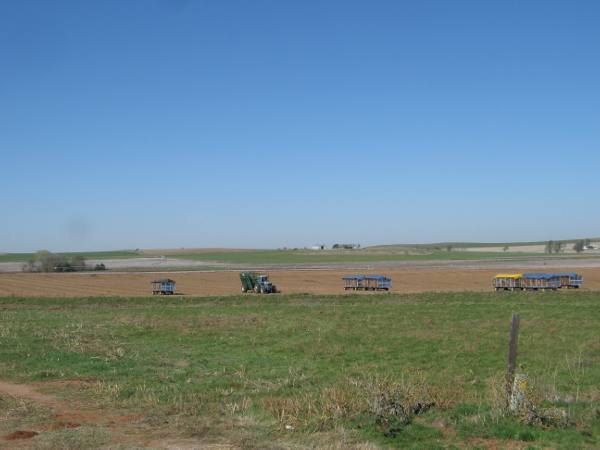November 8, 2012

On a clear morning in late October, the peanut transfer station operated by the Eichelberger Farms in Hydro, Oklahoma, handled brisk traffic as farmers lined up to weigh and unload their crop.
“We’re about half done with the harvest and we’re seeing above average yields when compared to last year,” says Doug Eichelberger.
Despite several frosts within the same week, the crop appeared unaffected. “So far, no frozen peanuts like in 2011,” says Eichelberger.
For six years, the Eichelbergers have been offloading peanuts for farmers located within a ten-mile radius. Despite the drought, the crop appears to have benefitted from ideally-timed moisture during the season.
“We saw over 115 degrees for two weeks straight during the summer. However, we did have timely rains at the end of the growing season. In my opinion, the crop was made during the last two weeks of August and into early September,” says Eichelberger.
When the family planted during the last week of April and into early May, the weather was favorable. “We basically had enough water to keep them alive. We have no reservoirs left at all,” says Eichelberger. He predicts harvest will be complete by mid-November.
Farmer Larry Miller and son Stenson Miller found themselves among many area producers waiting their turn to unload peanuts. Miller grew 250 acres of peanuts and rotates corn and wheat. “It works well for us,” he says. He also reported enough moisture to plant during the first week of May.
Because of the drought, disease pressure and pests were light or non-existent. “We had some pod rot on the Virginias,” says Miller, more than usual probably because they planted on new ground. They watered continuously from planting and yields are strong. “We expect to see 4,000 to 4,700 pounds per acre,” says Miller.
“For 2013, we may stay with the number of peanut acres or decrease due to rotation issues,” he adds.
Mike Kubicek, executive director of the Oklahoma Peanut Commission, says peanut acreage is divided almost equally among types. “We’re about 30 percent to 40 percent Spanish, 40 percent Runners, and 20 percent Virginias. We have a niche for the Spanish.” Farmers still double crop behind wheat and nearly all the acreage is irrigated.
“We’re about 99.4 percent irrigated in the state.”
Kubicek agrees with Miller that disease, even soil-born sclerotinia, is non-existent. Weed pressure is the biggest issue. “Like so many areas, we’re seeing more pigweed. We continue to rotate with corn and cotton as a management practice.”
In late October, Kubicek maintained a cautiously optimistic view despite the southwest part of the state experiencing three nights below 28 degrees. “The cold threat is still a problem with only 65 percent to 75 percent of the harvest complete.”
Oklahoma’s 2012 acreage remained largely unchanged from 2011 with approximately 20,000 acres in peanuts. Seventeen counties, spread across the state, are growing the crop. “We’ve seen some abandonment this year, but we’re pretty diverse. We run from the Texas/Oklahoma state line to 100 miles from Arkansas.”
Texas crop
Over in West Texas and the Texas Panhandle, peanut harvest was nearly complete by early November and well underway in South Texas.
“We expect all areas to be completely through with peanut harvest by mid-November. Yields have been reported as average to a little above average and are grading well. Considering the fact that we're still under drought conditions, farmers seem to be happy with peanut quality and yields,” says Shelly Nutt, executive director for the Texas Peanut Producers Board.
In Collingsworth County, Texas, Rusty Strickland harvested 90 percent of his 560-acre crop by early November and reports consistent three-ton yields. Growing a mixture of Runners and Spanish, Strickland reports exceptional grades. “We grow the 458 Runners and the OL07. The 458 have exceptional grades and it’s just a proven variety for this area,” says Strickland. About 25 percent of Strickland’s operation is Spanish, specifically ‘Golden’ variety.
Ninety percent of his acreage is irrigated.
“We were busier than we ever have been and ran the irrigation full time from May to September,” says Strickland.
The heat was exceptional in his area but not as bad as 2011. “We caught a break from the wind and had two or three small rains that went a long way for us.” Strickland rotates his crop every three years, planting cotton, wheat or milo in the off years.
Running a minimum-till operation, Strickland says weed resistance is a problem, but nothing he can’t control. “I’ll use Valor after I plant. There’s nothing we can’t control right now.”
With the 2012 peanut harvest almost in hand, farmers and buyers feel optimistic about this crop. Kubicek even ventures to say this year may break records. “We may break the 2008 yield records.”
You May Also Like




